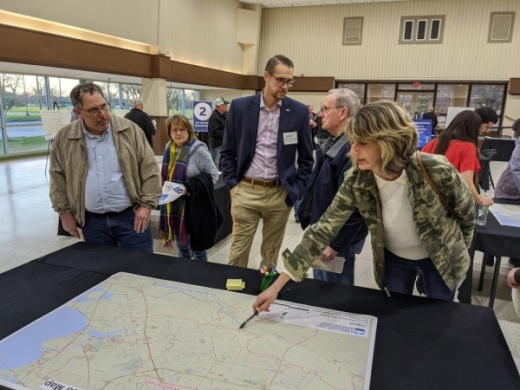Flooding and drainage experts from various cities and other partners hosted the first of four meetings about the Lower Clear Creek and Dickinson Bayou Watershed Study at Walter Hall Park in League City. The study is an in-depth look at how to solve regional Bay Area flooding and drainage issues.
The study is being done in three phases. Phase 1, which ends in the next couple months, includes gathering baseline data, evaluating funding opportunities and community outreach.
“We’re still in that front stage of gathering data,” League City project manager Anthony Talluto said.
Phase 2, which will finish by the end of the year, includes using advanced hydrologic and hydraulic models to predict how rainfall would affect the landscape and estimate how deep flooding would get in certain areas during hypothetical storms. For this phase, experts will rely on Atlas 14, which is a recent study of historical rainfall data that redefines the severity of 100- and 500-year storms, said Brian Gettinger, a project manager with consulting company Freese and Nichols.
Finally, Phase 3, which should wrap up by May 2021, will include identifying and developing projects that could mitigate regional flooding. These alternatives will be scored and ranked based on benefit, cost, ability to implement and effects to the community and environment. Another round of meetings will be held to inform residents of projects under consideration.
Potential projects for Clear Creek and Dickinson Bayou include removing silt, desnagging, removing trees and other obstructions to water flow, widening channels and more, Talluto said.
“Essentially everything’s on the table,” Gettinger said.
Talluto said this study will not result in projects that will improve drainage in local neighborhoods. Such projects are being handled at the local level in the League City and Friendswood.
However, regional flooding solutions will provide a way for water to more easily reach Galveston Bay, allowing cities to dump more water into Clear Creek and Dickinson Bayou during storms without either channel backing up as severely, officials said.
Dave Johnson—a League City resident and member of the Clear Creek Watershed Steering Committee, a group seeking regional flooding solutions—said it will take more than one city to mitigate area flooding.
“League City by itself cannot solve Harvey,” he said, “but together with all the other groups ... we can come together and then leverage ourselves and get higher amounts of dollars that we can bring in for meaningful projects.”
Gettinger said federal organizations that give grants, such as the Federal Emergency Management Agency, are more likely to fund and support higher-cost projects than cheaper ones, which makes it logical to identify several projects through one study rather than each partner trying to solve regional flooding issues locally.
“The big bureaucracy can’t get behind small pieces,” Gettinger said. “They want to get behind larger pieces.”
Additionally, by involving both counties and the Army Corps of Engineers right from the beginning instead of waiting until the study ends, it will be easier and faster to identify projects and get them through the process to completion, he said.
“It’s important to tackle it on a regional basis, which is what we’re trying to do,” Gettinger said. “We can look at it holistically. We can propose solutions that are larger scale.”
League City, and particularly City Manager John Baumgartner, were the catalysts for starting the project, officials said. The League City City Council a year ago tasked Baumgartner with launching a regional study to find ways to mitigate flooding, and steps were made throughout 2019.
Today, the study’s partners include League City, Harris County Flood Control District, Galveston County, the U.S. Army Corps of Engineers, Brazoria Drainage District, Pearland, Friendswood, Webster, Nassau Bay and Dickinson.
“John and League City deserve a lot of credit for getting us to this point now,” Gettinger said.
According to previous reports, the study costs about $1.5 million with each partner paying a share. Experts expect the three-phase study will be done by May 2021 but are hoping for sooner, Gettinger said.
“We’re gonna push harder to get it done before then,” he said. “Everyday we wait is another day people are exposed to storm risks.”
Residents can attend open houses next week to learn more about the project. The meetings will be held 6 to 8 p.m. March 3 at the Bay Area Community Center, 5002 NASA Parkway, Seabrook; March 4 at Friendswood Junior High School, 1001 Mansion Parkway, Friendswood; and March 5 at the League City Civic Center, 400 W. Walker St., League City.
To learn more, visit League City’s webpage about the project.





